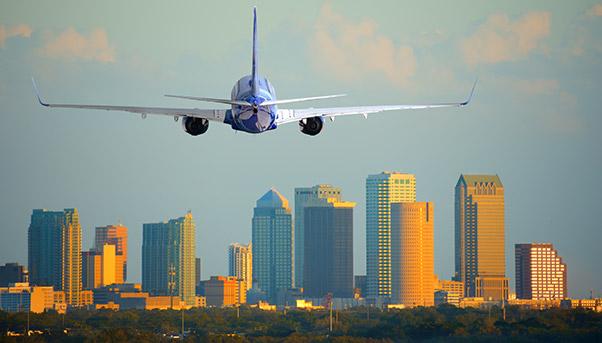
The campaign season for the mid-term elections in November is super-charging the competition between U.S. airports. And Florida looks like it is already a step ahead of the others in the game. And not just because President Donald Trump has his quartier generale at the Mar-a-Lago resort, and Air Force One makes regular stops at the Palm Beach International Airport, a runway linked by nearly 200 nonstop flights each day to 25 cities in the USA, Canada and the Caribbean, for over 6 million passengers each year.
In the last few years, Florida has demonstrated an unlimited passion for flying and air transport infrastructure. With 873 airports, between public and private, it has reached California (also 873 airports) and is now second only to Texas (which has 2,045). In 2017, the Miami-Fort Lauderdale-Orlando-Tampa quadrilateral alone produced an impressive figure of 140 million passengers, a 6-12% increase for individual international hubs.
Such frantic mobility derives from a significant increase in domestic tourism due to the sub-tropical climate that attracts visitors from the coldest areas of North America. It is also generated from the great entertainment attractions that drives international tourism and from a growing phenomenon of delocalization of both families and large companies.
If until five or six years ago Florida was considered a sort of “retreat” for the middle and upper class, today it is perceived as an area of great economic development, high technology, and strong fiscal incentives. Not surprisingly, in 2014 Florida exceeded the state of New York in terms of population, with the fastest growth in terms of new residents. Today, it has 21 million inhabitants, coming in third behind California (about 40 million) and Texas (28 million).
This ranking has immediate economic benefits, first and foremost a broader take-up of federal funds allocated for the reconstruction plans desired by U.S. President Donald Trump — they will flow to each State precisely on the basis of their population. The improvement of airports is an important chapter in America’s reconstruction program.
Airport investments in Florida
The “Blueprint to Rebuild America’s Infrastructure,” elaborated by the Senate, shows a $30 billion budget for air infrastructure. According to the Senate document, aviation is able to produce over a trillion dollars of new economic activities, with the creation of over 390,000 jobs. Investments in airport infrastructure have so far been significantly lower than necessary. According to the latest estimate of the Federal Aviation Administration (FAA), in the next five years there will be $32.5 billion airport projects eligible for federal airport improvement program funds, while at current spending levels only $16.5 billion will be available to meet these needs.
As in other sectors, each State draws on local taxes to finance its projects. In Florida, the use of aviation fuel taxes to finance airport construction dates back to 1983. Since then, over $3 billion has been allocated by Florida lawmakers to the Florida Aviation Project.
Projects for the largest airports
The insufficient federal or state funds have not stopped the rapid development of the airport system. On the I-75 interstate highway from Tampa to Miami and Fort Lauderdale, one can see dozens of airports for both commercial airlines and private jets. The planes are always full and the airports are super-crowded. Often the reason why airports exist is linked to the country of origin of the tourists or of those who own homes and businesses in these areas.
Fort Myers airport, called Southwest Florida International, is a great example: it serves the rich area of Naples and Marco Island, with seasonal non-stop connections to Germany and daily journeys to Canada. The airport is among the top 50 in the United States, with a traffic volume of almost 9 million passengers in 2017. «In February, for the first time in our 35-year history, we had over a million passengers», said Jeff Mulder, executive director of the Port Authority for the Lee County. The Fort Myers airport has only one asphalt runway, but the county plans to build a second runway by 2020.

In 2017, the international airport of Tampa, thanks also to direct connections with major European hubs such as London, Frankfurt, and Zurich, has reached the threshold of 20 million passengers. The airport is undergoing a major infrastructural transformation thanks to the $1 billion state budget obtained in 2015. The final plan will accommodate up to 35 million passengers every year.
New junctions, bridges and high-speed roads have also been built around the airport to relieve traffic around the Tampa belt, which has one of the highest rates of infrastructure development in the United States. «This is a great day for Tampa Bay», said airport CEO Joe Lopano, inaugurating the new Sky Connect system, which connects the main terminal to the long-term garage and the new car rental center. «This project is worthy of our history and will be admired as we admire the projects of the past». For the governor of Florida, Rick Scott, «the economic effects of the project will be felt in the years to come».
In the last 10 years, Miami has experienced a sudden increase in air traffic, and state programs have struggled to keep pace with the development of the airport, making it one of the most congested in North America. In 1994, a master plan was adopted to support the development needs of the Miami-Dade County airport; its latest investment program amounts to $6.4 billion to equip Miami with four runways, new taxiways, many more boarding, extended parking lots, more efficient road links and passenger collection.
On the other hand, the task is challenging: Miami International Airport says in 2017 it generated about $35 billion of commercial revenue for the county, supports over 280,000 jobs and moves over 44 million passengers and more than two million tons of goods a year.
Miami will also have to recover from being overtaken by the international airport of Orlando, with about 45 million passengers, which it suffered last year. For Orlando, the overall growth in 2017 was 6.4%, which represents an increase of almost 2.7 million passengers compared to the previous 2016 record.
To fuel the economic benefit of the region, where the airport generates annual revenue of $31 billion, the upgrading of motorway link infrastructures is already underway.
Next to Miami, also Fort Lauderdale international airport is growing, with 32.5 million passengers in 2017, 11.3% more than the previous year. A double-digit trend that has been repeated for the fourth consecutive year and that has led the airport to exceed the capacity of Philadelphia or La Guardia airport in New York, and enter the top 20 of the United States. Broward County, which manages the international airport and that of North Perry dedicated to private aviation and charter flights, has started the search for qualified companies in order to receive offers on design and construction projects for both airports.
Airports that double as cities
Of the 873 airports or flight infrastructures, including public and private facilities, some of them are air communities (Fly-In), offering places to live alongside the planes. The concept of a residential airport took off after World War II, a period when the United States had an incredible abundance of airports and pilots. According to Living With Your Plane, an online directory of airparks and resource center, there are more than 630 fly-in communities worldwide. This list includes the largest and most well-known residential areas of aviation in the world, the multitude of small hidden gems scattered near and far.
Florida leads the group with over 70 airparks. Texas and Washington follow closely with more than 65 and 50, respectively.
Probably the most famous airpark is in Ocala, north of Tampa — not so much for air traffic, but for its first and most famous resident, John Travolta. The actor is a professional pilot, Qantas ambassador and owns 5 planes among which a Qantas Boeing 707, parked on one side of his home-airport.

